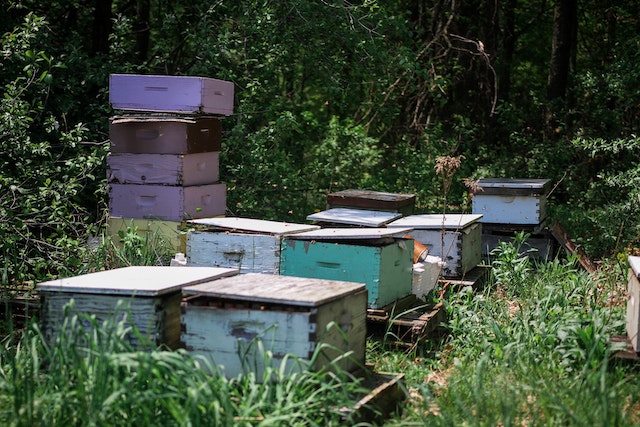
Why are bees transported across countries by truck? Bees are the largest pollinator of many of the foods we eat and they have to be transported to where the foods are grown.
Bees are the most common pollinator but not by any means the only. Bees travel from their hive to find flowers. When they find one, they enter the flower looking for nectar. Nectar is made of water, sugar, carbohydrates, amino acids, and proteins. It varies from plant to plant, but most nectar is about 50% sugar. When they are collecting the nectar, the bees have to brush past the stamen, which is the male part of the plant, and they get covered in pollen. Bees have evolved hairs to pick up the pollen and flowers have evolved to give them nectar in return for them picking up the pollen. The bee then flies off to another flower to get more nectar and puts the pollen it is carrying on the stigma, which is the female part of the plant, thereby pollinating it. The bee carries the nectar back to the hive where they make honey with it. Different bees have evolved to take nectar from different flowers. There are 20,000 different bee species in the world.
So, why are bees transported across countries by truck? Bees will naturally fly around looking for nectar and they will naturally pollinate flowers. This is a process that happens with or without us. The problem is that humans have changed the way that we grow crops. It used to be that a bee would fly around and there would be a huge variety of flowers. The bees would choose the ones that were most appealing, and they would have a variety of nectar in their honey. That is good for the bees, and it is good if you want honey, but it is not good if you want to mass-produce a crop. We have moved from small farms growing a variety of crops to enormous farms growing a single crop. And these farms are usually not located where the bees are. So, bees are needed to pollinate them.
The almond industry in America is a good example. California is the center of almond production in the USA and produces 80% of the world’s almonds. The climate is perfect and waterways have been constructed to irrigate the crops. There are 1.25 million acres of almond farms in California, which is 5,100 km2, and they produce 1.3 million tons of almonds every year. The amount of land devoted to almonds is increasing each year because demand is rising. Almond flowers have to be cross-pollinated and the most common pollinators are the honey bee, the blue orchard bee, and the wild bee. If an almond tree is not pollinated it will not produce a nut. When a bee carries pollen from the stamen to the stigma, it fertilizes the ovary. The ovary swells up and forms around the seed at its center. The seed is the almond and when it is ready, the fruit around it splits open, leaving the almond. Almonds are not actually nuts; they are called drupes.
If the flowers aren’t pollinated, they won’t produce almonds and one acre of almond trees needs approximately 40,000 bees to pollinate it. The almond farms are not naturally occurring and there are not enough bees in the area. The bees have generally been forced off the land by the production of farms. One of the many reasons why the number of insects is dropping dangerously is the way we farm. Almond producers need their bees, so, every pollination season, they rent bees from beekeepers. Renting bees can be a large part of a beekeeper’s income. Often far more than they would get from selling honey alone.
Beekeepers load beehives onto trucks. One truck can carry about 15 million bees. The hives are sealed and then driven across the country to the almond farm. The hives are placed throughout the almond trees and then they are opened, hopefully, to pollinate the trees. I say hopefully because a large percentage of the bees, sometimes whole colonies, die in transit. Beekeepers generally ship three hives for every two that they need. The stress of moving or sometimes the temperature change can be fatal. However, without this process, the almond industry wouldn’t be able to function and we wouldn’t be able to get the almonds and the almond milk we have become addicted to.
The almond industry isn’t the only industry that depends on shipping bees and America isn’t the only country. Most large commercial farms that grow anything needing to be pollinated rent bees. And the American government considers the honey bee livestock because it is vital to the food industry. And this is what I learned today.
Photo by Maria Lindsey Content Creator: https://www.pexels.com/photo/boxes-of-bee-hives-on-apiary-5645976/
Sources
https://www.npr.org/2017/03/09/519500033/bees-travel-cross-country-for-the-california-almond-harvest
https://www.freightwaves.com/a-day-in-the-life-of-a-honeybee-trucker
https://www.ers.usda.gov/webdocs/publications/101476/err-290.pdf?v=6865.6
https://en.wikipedia.org/wiki/Almond_cultivation_in_California
https://www.museumoftheearth.org/bees/eat-pollination
https://www.usgs.gov/faqs/how-many-species-native-bees-are-united-states
https://www.gardeningknowhow.com/edible/nut-trees/almonds/how-are-almond-trees-pollinated.htm
http://icpbees.org/wp-content/uploads/2016/07/CA-Almond-Pollination-Factsheet-FINAL-v2.pdf
https://www.theguardian.com/science/blog/2016/nov/10/hips-haws-and-drupes-when-is-a-nut-not-a-nut
https://www.usatoday.com/story/life/food-dining/2023/07/04/where-do-almonds-come-from/70342254007/
https://www.theguardian.com/environment/2020/jan/07/honeybees-deaths-almonds-hives-aoe
